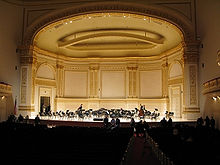Carnegie Hall
Carnegie Hall [ˌkɑrnəɡi ˈhɔl] is a concert hall in Manhattan in New York City, located at the corner of 57th Street and 7th Avenue. It is one of the most famous venues for both classical and jazz and pop concerts in the United States.
The building bears the name of Andrew Carnegie, who financed its construction. William Burnet Tuthill designed the concert hall as a brick structure in the Italian Renaissance style. Construction began in 1890, and the first use was in April 1891; however, completion did not occur until 1897, with the official opening taking place on May 5, 1891. Russian composer Pyotr Ilyich Tchaikovsky personally conducted through his works for five evenings. For two dollars admission, one could experience a world star at this premiere; the cheapest ticket in the stands cost only 45 cents.
Carnegie Hall originally had three concert halls: the Main Hall ("Great Hall"), the Recital Hall ("Small Hall") and the Chamber Music Hall ("Chamber Music Hall").
The large hall has been called the "Isaac Stern Auditorium" since its renovation in 1986. It offers seating for 2,800 spectators on five levels. Its acoustics are famous; it is considered one of the best concert halls in the world. The chamber music hall on the third floor of Carnegie Hall (270 seats) has been named "Joan and Sanford L. Weill Recital Hall" since 1986. The small hall in the basement was leased to the AADA (American Academy of Dramatic Arts) in 1898 and converted into a movie theater after 1960. Since 1997, a modern multi-purpose hall with 600 seats was built here, the "Judy and Arthur Zankel Hall", which opened in 2003. Carnegie Hall is also home to the Rose Museum and the Carnegie Hall Archives.
The building was owned by the Carnegie family until Carnegie's widow sold it to real estate broker Robert E. Simon in 1924. The building was operating at a loss; the owner offered it to the New York Philharmonic for sale. The Philharmonic declined, as they were already in the process of moving to Lincoln Center in 1960. Plans emerged to demolish the building and erect a 44-story commercial building in its place. Under pressure from an initiative led by violinist Isaac Stern, a legal decision was made that allowed the City of New York to purchase the hall in 1960 for five million dollars and lease it to a nonprofit organization. In December 1962, Carnegie Hall was declared a National Historic Landmark. The concert hall was the venue for the Dimitri Mitropoulos International Music Competition.
The building was extensively renovated from 1983 to 1995.
Despite Carnegie Hall's landmark status, plans for a commercial building were not completely abandoned: in 1987-1989, a 60-story residential and office building, called Carnegie Hall Tower, was built adjacent to Carnegie Hall on the same block.

View to the stage

Main entrance of Carnegie Hall
See also
- List of the tallest buildings in New York
Questions and Answers
Q: What is Carnegie Hall?
A: Carnegie Hall is a concert hall located in New York.
Q: Who provided the money for building Carnegie Hall?
A: The money for building Carnegie Hall was given by Andrew Carnegie, a wealthy businessman from Scotland.
Q: When was Carnegie Hall built?
A: Carnegie Hall was built in 1891.
Q: What is the significance of Carnegie Hall?
A: Carnegie Hall is the most famous concert hall in the world.
Q: How many separate concert halls does Carnegie Hall have?
A: Carnegie Hall has three separate concert halls, namely the Main Hall, the Recital Hall, and the Chamber Music Hall.
Q: What is the importance of the Main Hall at Carnegie Hall?
A: The Main Hall is the largest of the three concert halls at Carnegie Hall and is known for its excellent acoustics.
Q: What is the difference between the Recital Hall and the Chamber Music Hall at Carnegie Hall?
A: The Recital Hall is larger and intended for solo or small ensemble performances, while the Chamber Music Hall is smaller and designed for intimate performances.
Search within the encyclopedia